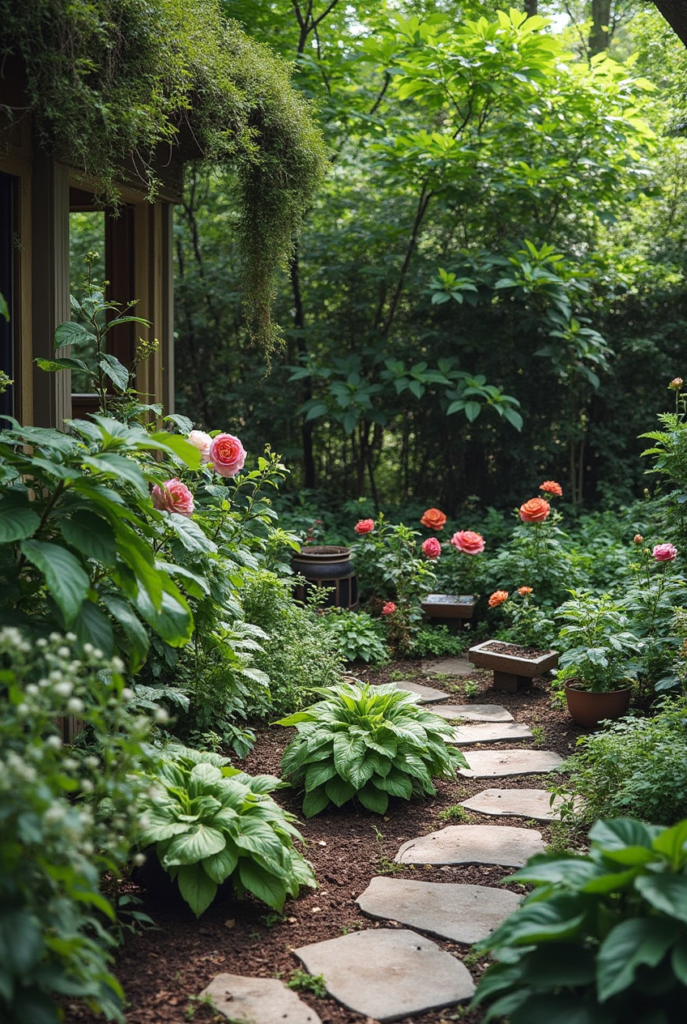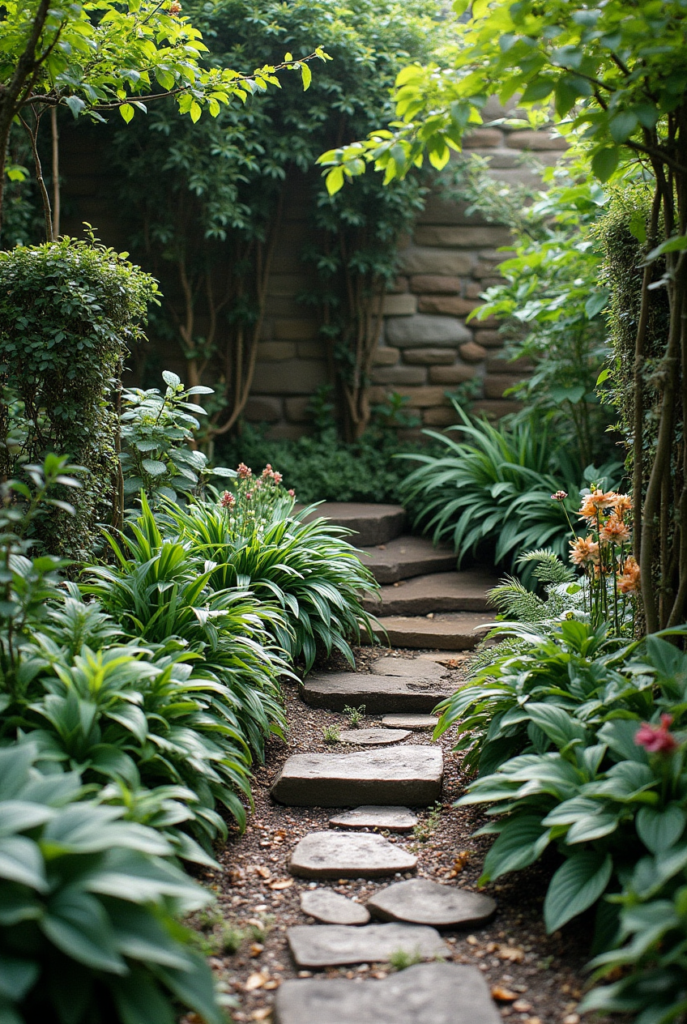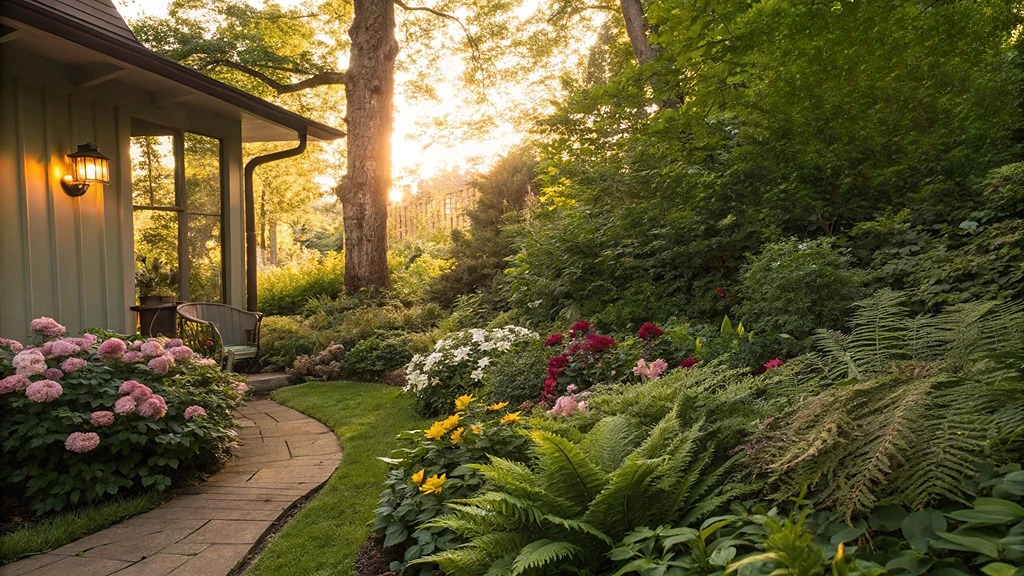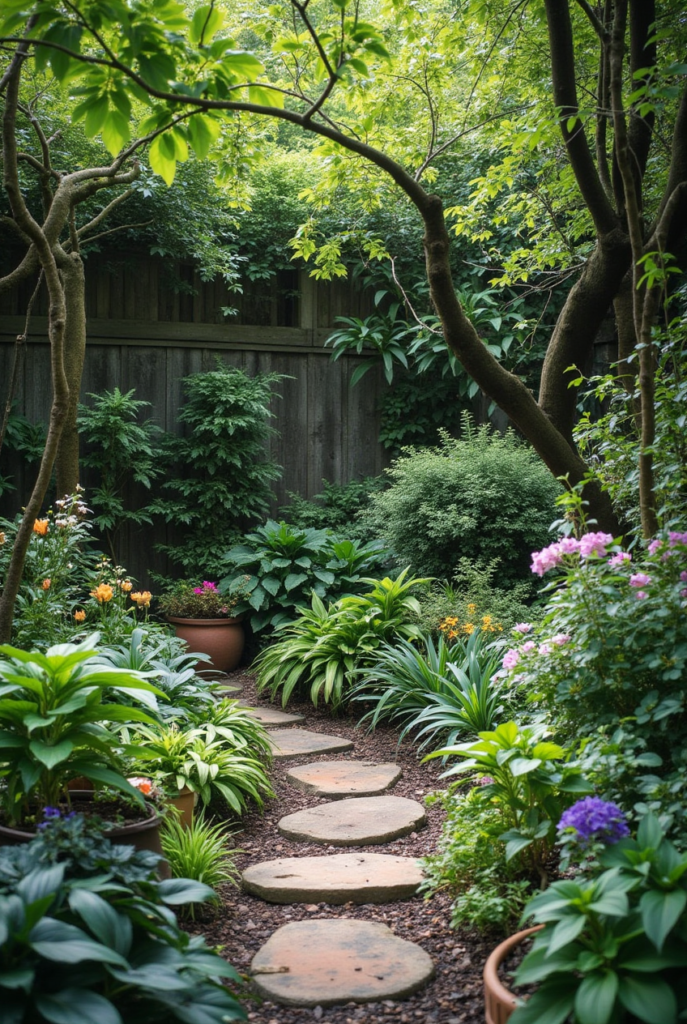Are you struggling with a dim, neglected shady garden corner? You’re not alone. Many homeowners find themselves puzzled when faced with those challenging spots where sunlight rarely reaches. But what if I told you that these overlooked areas could become the most enchanting parts of your landscape?
I remember staring at my own north-facing corner—damp, dark, and desperately empty—wondering if anything beyond moss would ever thrive there. After years of experimentation and some delightful discoveries, I’ve learned that shady corners don’t have to be garden afterthoughts; they can be star attractions brimming with color, texture, and life.
In this comprehensive guide, we’ll explore 20 creative and practical shady garden corner ideas that will help you transform those challenging spots into vibrant, eye-catching features. Whether you’re working with deep shade under mature trees or dappled light along a fence line, these solutions will breathe new life into every forgotten corner of your garden sanctuary.
Table of Contents
Understanding Your Shady Garden Corner
Before diving into design ideas, it’s essential to assess exactly what type of shade you’re dealing with in your garden corner.
Types of Shade in Garden Corners
Not all shade is created equal. Understanding the specific conditions in your shady garden corner will help you select the right plants and design elements:
| Shade Type | Description | Best Plants | Challenges |
|---|---|---|---|
| Deep Shade | Less than 2 hours of direct sunlight; often found under dense tree canopies or north-facing walls | Hostas, ferns, astilbe, heuchera | Limited plant options, potential moisture issues |
| Partial Shade | 2-4 hours of direct sunlight; typically morning sun with afternoon shade | Hydrangeas, Japanese maples, hellebores, brunnera | Balancing moisture needs, moderate plant range |
| Dappled Shade | Filtered light through tree branches | Bleeding hearts, foxgloves, tiarella, woodland phlox | Variable light conditions, competition with tree roots |
| Morning Shade/Afternoon Sun | East-facing corners with shade early, sun later | Geraniums, daylilies, astrantia, Japanese anemones | Plants need to tolerate both conditions |
Evaluating Your Soil Conditions
The success of your shady garden corner depends heavily on understanding and potentially amending your soil:
- Test soil pH: Most shade plants prefer slightly acidic to neutral soil (5.5-7.0 pH)
- Check drainage: Many shady corners suffer from excessive moisture or, conversely, dry conditions under trees
- Assess organic content: Shade areas often need additional organic matter to support plant growth
- Consider competition: Tree roots may compete for nutrients and water in some shady corners
20 Shady Garden Corner Ideas for Every Style
1. Woodland Retreat Corner
Transform your shady garden corner into a serene woodland sanctuary by layering plants of different heights and textures. Begin with a small Japanese maple or dogwood as a focal point, then add mid-height ferns, hostas, and astilbes. Complete the look with a ground cover of sweet woodruff or wild ginger.
Key elements:
- Leaf mulch to mimic forest floor
- Natural stone path or stepping stones
- Woodland wildflowers for seasonal color
- Small water feature for gentle sound
- Rustic wooden bench for contemplation
2. Tropical Paradise Pocket
Even in shade, you can create a lush tropical paradise in your garden corner using broad-leafed plants that thrive in low light.
Plant selection:
- Fatsia japonica for dramatic foliage
- Hardy palms like Trachycarpus fortunei
- Large-leafed hostas in varieties like ‘Sum and Substance’
- Variegated ginger for exotic flair
- Rodgersia for impressive textural impact
Add decorative elements like bamboo screens, tropical-inspired garden art, and recycled containers planted with colorful caladiums to complete the exotic feel.
3. Modern Minimalist Shade Corner
Create a clean, contemporary look in your shady garden corner with these elements:
- Architectural shade plants like tree ferns or black mondo grass
- Oversized concrete planters with simple, bold specimens
- Strategic uplighting to create dramatic nighttime effects
- Ground cover of moss or black pebbles for texture contrast
- Geometric hardscaping elements like concrete pavers or metal edging
This approach emphasizes form over abundance and can make a shady corner feel intentional rather than neglected.
4. Colorful Shade Container Collection
For renters or those seeking flexibility, transform your shady garden corner with a curated collection of containers.
Container tips for shade:
- Use larger containers that retain moisture better
- Ensure adequate drainage holes
- Select lightweight materials if you’ll need to move them
- Group containers of varying heights and widths
- Create color themes that pop in low light (whites, silvers, yellows)
Plant coleus, begonias, impatiens, caladiums, and fuchsias for reliable color even in challenging light.
5. Meditation Corner Retreat
A shady garden corner naturally lends itself to becoming a peaceful meditation space where you can escape from daily stress. Consider including:
- Comfortable seating (weather-resistant cushions on a built-in bench)
- Sound elements (wind chimes, small fountain)
- Aromatic shade-tolerant plants like sweetbox (Sarcococca)
- Thoughtfully placed garden sculptures or a small Buddha figure
- Simple, low-maintenance plantings to minimize distraction
The filtered light of a shady corner creates the perfect atmosphere for contemplation and mindfulness.
6. Shade-Loving Native Plant Habitat
Embrace ecological gardening by focusing on native plants adapted to shade in your region:
Benefits of native shade plants:
- Require less maintenance once established
- Support local wildlife and pollinators
- Typically more disease-resistant
- Often thrive with minimal intervention
- Create authentic sense of place
Research indigenous woodland plants from your region—trilliums, native ferns, wild gingers, and woodland phlox make excellent choices for many North American gardens.
7. Vertical Shade Garden
Limited ground space? Go vertical with your shady garden corner by installing:
- Wall-mounted planters for ferns and trailing plants
- Trellises supporting climbing hydrangea or chocolate vine
- Hanging baskets with fuchsias or begonias
- Pocket planters filled with shade-tolerant specimens
- Repurposed wooden pallets as vertical planting surfaces
This approach maximizes the growing space while creating visual interest from ground to roofline.
8. Moss and Stone Japanese-Inspired Corner
For a serene, low-maintenance shady garden corner, embrace the Japanese aesthetic of celebrating shade:
![Japanese garden corner with moss and stone elements]
Key components:
- Various moss species as ground cover
- Carefully placed natural stone elements
- Miniature Japanese maples or dwarf conifers
- Simple bamboo water feature
- Minimal but thoughtful plant selection
- Stone lantern as focal point
This style accepts and celebrates the shaded condition rather than fighting against it.
9. Shade-Friendly Children’s Corner
Create a magical play space in your shady garden corner that engages children’s imagination:
- Fairy garden elements tucked among ferns
- Weather-resistant storage for outdoor toys
- Natural elements for creative play (logs, stones, diggable soil)
- Child-safe shade plants like lungwort and foam flower
- Whimsical decorations that glow or reflect light
The cool comfort of a shady corner makes it ideal for active play even during warmer months.
10. Wildlife-Friendly Shade Corner
Transform your shady garden corner into a haven for local wildlife with these elements:
Wildlife attractions:
- Bird bath positioned for visibility but with nearby protective cover
- Native berry-producing shrubs like serviceberry
- Small brush pile for beneficial insects and small creatures
- Host plants for shade-tolerant butterfly species
- Water source such as a small pond or fountain
The resulting habitat will bring your corner alive with visitors year-round.

11. Edible Shade Garden Corner
Contrary to popular belief, many edible plants thrive in partial to full shade:
| Edible Plant | Shade Tolerance | Growing Tips |
|---|---|---|
| Mint varieties | Full to partial shade | Contain in pots to prevent spreading |
| Alpine strawberries | Dappled shade | Perfect ground cover with tiny, intense berries |
| Ramps/wild leeks | Deep shade | Slow-growing woodland delicacy |
| Currants | Partial to full shade | Productive shrubs with minimal care |
| Hostas | Full shade | Young shoots are edible like asparagus |
| Mushroom logs | Deep shade | Shiitake or oyster varieties for home growing |
This productive corner can yield culinary treasures while solving a garden challenge.
12. Romantic Victorian Shade Corner
Create a nostalgic retreat with these classic elements:
- Ornate metal bench or bistro set painted white or black
- Victorian-style plant stand with multiple tiers
- Shade-loving heritage plants like bleeding hearts and lily-of-the-valley
- Decorative bird cage planted with trailing ferns
- Antique garden implements as art pieces
- Path of reclaimed bricks or vintage tiles
This style brings historical charm to a challenging garden space.
13. Drought-Tolerant Shade Corner
For areas that are both shady AND dry (like under trees or roof overhangs):
Plant selections:
- Epimedium (bishop’s hat)
- Liriope (lilyturf)
- Bergenia (elephant’s ears)
- Hellebores
- Certain sedums and sempervivums
Use gravel mulch to conserve moisture and incorporate elegant, drought-tolerant structure plants like yucca ‘Color Guard’ for year-round interest.
14. Fern Glade Corner
Celebrate the ancient elegance of ferns in your shady garden corner:
- Mix multiple fern varieties for textural contrast
- Use fallen logs as natural planting surfaces
- Add shade-loving spring bulbs for seasonal color
- Incorporate stone elements that will gather moss over time
- Consider a simple water feature to increase humidity
Ferns offer incredible diversity, from tiny maidenhair varieties to massive tree ferns, making them perfect for dedicated displays.
15. Shade-Friendly Entertaining Corner
Design a comfortable gathering space in your shady garden corner:
Key elements:
- Weather-resistant furniture with comfortable cushions
- Solar or battery-operated lighting for evening use
- Small side tables for drinks and snacks
- Mosquito-repelling plants like citronella-scented geraniums
- Decorative but simple plantings that don’t require constant maintenance
The cool shade creates a perfect retreat for summer entertaining when other parts of the garden may be too hot.
16. Seasonal Shade Garden Corner
Design your shady garden corner to shine in different seasons:
- Early spring: Hellebores, pulmonaria, and spring bulbs
- Late spring: Bleeding hearts, fern fronds unfurling, woodland phlox
- Summer: Astilbes, hostas at peak, hydrangeas blooming
- Fall: Japanese maple color, toad lilies, autumn ferns
- Winter: Evergreen ferns, berried plants, structural elements
This thoughtful planning ensures year-round interest rather than a space that looks good for only a few weeks.
17. Repurposed Materials Shade Corner
Create an eclectic, budget-friendly shady garden corner using reclaimed items:
- Old wooden ladder as plant stand
- Vintage sink or bathtub as unique planter
- Recycled stepping stones made from broken concrete
- Repurposed metal objects as garden art
- Old wooden furniture transformed into planters

This approach adds personality while being environmentally friendly and cost-effective.
18. Hosta Collector’s Corner
Dedicate your shady garden corner to the incredible diversity of hostas:
Hosta variety examples:
- ‘Blue Mouse Ears’ (miniature blue-green)
- ‘Sum and Substance’ (giant chartreuse)
- ‘White Feather’ (dramatic white emerging foliage)
- ‘Patriot’ (dark green with crisp white edges)
- ‘June’ (blue-green with creamy center)
Arrange by size, color, or leaf shape, and add companion plants like coral bells and Japanese forest grass for contrast.
19. Rainy Climate Shade Corner
For gardens in wet regions, embrace moisture-loving plants:
- Ligularia with its bold foliage and yellow blooms
- Astilboides with massive round leaves
- Primroses for early color
- Japanese iris for vertical interest
- Rodgersia for dramatic textural impact
Include a rain chain or small rain garden feature to manage water flow aesthetically.
20. Poor Soil Shade Corner Solution
When dealing with challenging conditions like heavy clay, tree roots, or depleted soil:
Solutions:
- Raised beds or berms to create fresh planting areas
- Container groupings that sit above problem soil
- Tough, adaptable plants like epimedium and bigroot geranium
- Heavy mulching to gradually improve soil quality
- Groundcovers that thrive in difficult conditions like sweet woodruff or ajuga
This pragmatic approach acknowledges limitations while still creating beauty.
Maintaining Your Shady Garden Corner
Once you’ve created your perfect shady garden corner, proper maintenance will keep it looking its best:
Seasonal Maintenance Calendar
Spring:
- Cut back previous year’s perennial foliage before new growth emerges
- Apply fresh layer of compost around plants
- Divide and transplant overcrowded perennials
- Check for slugs and snails, which favor shady conditions
Summer:
- Monitor moisture levels—shade doesn’t always mean wet
- Deadhead spent flowers to encourage reblooming where applicable
- Trim back any plants becoming leggy due to reaching for light
- Apply mulch to retain moisture during hot periods
Fall:
- Plant spring-flowering bulbs like snowdrops and anemones
- Allow leaves to remain as natural mulch where appropriate
- Take photographs to identify bare spots for spring planting
- Divide overcrowded hostas and other perennials
Winter:
- Protect container plants from freeze-thaw cycles
- Check for broken branches after storms
- Plan additions and changes for spring
- Enjoy evergreen structure and winter interest elements
Conclusion
Your shady garden corner no longer needs to be that challenging, forgotten space where nothing grows. With thoughtful design choices and appropriate plant selection, these often-overlooked areas can become the most captivating parts of your garden. Whether you prefer lush woodland textures, colorful blooms against emerald backdrops, or contemplative minimalism, there’s a shady garden corner idea perfect for your space.
Remember that successful shade gardening is about working with nature rather than against it. By embracing the unique conditions of your shady garden corner and selecting plants that naturally thrive there, you’ll create a sustainable, low-maintenance space that brings joy throughout the seasons.
Which of these shady garden corner ideas resonates most with your personal style and garden conditions? The possibilities are endless—your perfect shade solution awaits!
Frequently Asked Questions About Shady Garden Corners
What plants add the most color to a shady garden corner?
While shade gardens are often celebrated for foliage, many plants offer vibrant blooms even in low light. For reliable color in your shady garden corner, try astilbes, impatiens, begonias, coleus (for foliage color), heucheras, and toad lilies. Hydrangeas also perform beautifully in partial shade and provide months of colorful blooms.
How do I deal with dry soil in my shady garden corner?
Dry shade—often found under trees or eaves—is particularly challenging. Improve the area by adding organic matter to increase water retention, mulching heavily to preserve moisture, and selecting tough plants like epimediums, hellebores, and certain geraniums that tolerate these conditions once established. Consider occasional deep watering rather than frequent shallow irrigation.
Can I grow vegetables in my shady garden corner?
While full sun is ideal for most vegetables, several edibles tolerate partial shade. Leafy greens like lettuce, spinach, kale, and arugula often perform better with afternoon shade in hot climates. Herbs including mint, parsley, and chives also grow well in dappled light. Root vegetables like radishes and beets can manage with 4-6 hours of sun.
How do I brighten up a dark shady garden corner?
Incorporate plants with variegated or light-colored foliage that reflect available light, such as Japanese forest grass or variegated hostas. Add mirrors strategically positioned to bounce light into darker areas. Use light-colored hardscaping materials and containers, and incorporate solar-powered landscape lighting for evening illumination. White or pale-colored flowers also stand out beautifully against dark backgrounds.
What’s the best way to combat moss in my shady garden corner?
Rather than fighting moss, consider embracing it as a natural, low-maintenance ground cover perfect for shade. If removal is necessary, improve air circulation by pruning overhanging branches, address drainage issues, adjust soil pH with lime if it’s too acidic, and physically remove moss followed by application of appropriate ground covers or mulch to prevent its return.

